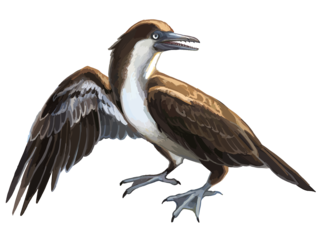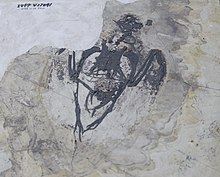
Caudipteryx is a genus of small oviraptorosaur dinosaurs that lived in Asia during the Early Cretaceous, around 124.6 million years ago. They were feathered and extremely birdlike in their overall appearance, to the point that some paleontologists suggested it was a bird. Two species have been described: C. zoui, in 1998, and C. dongi, in 2000.

Confuciusornis is a genus of basal crow-sized avialan from the Early Cretaceous Period of the Yixian and Jiufotang Formations of China, dating from 125 to 120 million years ago. Like modern birds, Confuciusornis had a toothless beak, but closer and later relatives of modern birds such as Hesperornis and Ichthyornis were toothed, indicating that the loss of teeth occurred convergently in Confuciusornis and living birds. It was thought to be the oldest known bird to have a beak, though this title now belongs to an earlier relative Eoconfuciusornis. It was named after the Chinese moral philosopher Confucius. Confuciusornis is one of the most abundant vertebrates found in the Yixian Formation, and several hundred complete specimens have been found.

The Enantiornithes, also known as enantiornithines or enantiornitheans in literature, are a group of extinct avialans, the most abundant and diverse group known from the Mesozoic era. Almost all retained teeth and clawed fingers on each wing, but otherwise looked much like modern birds externally. Over eighty species of Enantiornithes have been named, but some names represent only single bones, so it is likely that not all are valid. The Enantiornithes became extinct at the Cretaceous–Paleogene boundary, along with Hesperornithes and all other non-avian dinosaurs.

Beipiaosaurus is a genus of therizinosauroid theropod dinosaurs that lived in China during the Early Cretaceous in the Yixian Formation. The first remains were found in 1996 and formally described in 1999. Before the discovery of Yutyrannus, Beipiaosaurus were among the heaviest dinosaurs known from direct evidence to be feathered. Beipiaosaurus is known from three reported specimens. Numerous impressions of feather structures were preserved that allowed researchers to determine the feathering color which turned out to be brownish.

Yanornis is an extinct genus of fish-eating Early Cretaceous birds. Two species have been described, both from Liaoning province, China: Yanornis martini, based on several fossils found in the 120-million-year-old Jiufotang Formation at Chaoyang, and Yanornis guozhangi, from the 124-million-year-old Yixian Formation.

Liaoningosaurus is an unusual genus of basal ankylosaurid dinosaur from the Liaoning Province, China that lived during the Early Cretaceous in what is now the Yixian and Jiufotang Formation. The type and only species, Liaoningosaurus paradoxus, is known from more than 20 specimens, with some representing juveniles. It was named in 2001 by Xu, Wang and You.

Jeholornis is a genus of avialan dinosaurs that lived between approximately 122 and 120 million years ago during the early Cretaceous Period in China. Fossil Jeholornis were first discovered in the Jiufotang Formation in Hebei Province, China and additional specimens have been found in the older Yixian Formation.

Sapeornis is a monotypic genus of avialan dinosaurs which lived during the early Cretaceous period. Sapeornis contains only one species, Sapeornis chaoyangensis.

Hongshanornis is a genus of ornithuromorph birds known from early Cretaceous lake deposits of the Yixian Formation, Inner Mongolia, China. The holotype specimen, recovered in 2005, is currently held by the Institute of Vertebrate Paleontology and Paleoanthropology in Beijing. It was found in the Jianshangou fossil beds, dated to 124.6 million years ago. Three additional specimens have been reported, though only one of those has been definitively identified as belonging to Hongshanornis. This latter specimen was found in the Dawangzhangzi fossil beds, which are about 122 million years old.

Yixianornis is a bird genus from the early Cretaceous period. Its remains have been found in the Jiufotang Formation at Chaoyang dated to the early Aptian age, around 120 million years ago. Only one species, Yixianornis grabaui, is known at present. The specific name, grabaui, is named after American paleontologist Amadeus William Grabau, who surveyed China in the early 20th century.

Tianyuraptor is a genus of short-armed dromaeosaurid dinosaur that lived during the Early Cretaceous, about 122 million years ago. Its remains have been found in western Liaoning, China. It was similar to other dromaeosaurids found in Liaoning, with the exception of being somewhat more primitive. The type specimen, formally named in 2009, shows features not seen in previously known Northern Hemisphere (Laurasian) dromaeosaurids, but present in Southern Hemisphere (Gondwanan) species and early birds. Because of this, the scientists who first studied Tianyuraptor described it as a "transitional species", bridging the gap between northern and southern types of dromaeosaurid. Tianyuraptor also differs from previously known dromaeosaurids in that it possesses a relatively small furcula ("wishbone"), and unusually short forelimbs.
Longicrusavis is an extinct genus of basal ornithuromorph bird found only at Dawangzhangzi village in Liaoning Province, China. Longicrusavis was a ground dwelling carnivore, a wader, and part of biological family Hongshanornithidae, considered to have been a dominant species in the Jehol Biota, the prehistoric Chinese ecosystem which supported them. The name Hongshanornithidae represents one of China's oldest recorded cultures in the region, the Hongshan culture.
Hongshanornithidae is an extinct group of early ornithuromorph birds from the early Cretaceous period of China. It includes the genera Hongshanornis and Tianyuornis from the Yixian Formation of Inner Mongolia, Longicrusavis from the Yixian Formation of Liaoning Province, Parahongshanornis from the Jiufotang Formation of Liaoning Province, and Archaeornithura, the oldest known member, from the Huajiying Formation of Hebei Province.

Songlingornithidae is a family of basal euornithean dinosaurs from the Early Cretaceous of China. All known specimens come from the Jiufotang Formation and the Yixian Formation, dating to the early Barremian and Aptian ages, 125–120 million years ago.

Chuanqilong is a monospecific genus of basal ankylosaurid dinosaur from the Liaoning Province, China that lived during the Early Cretaceous in what is now the Jiufotang Formation. The type and only species, Chuanqilong chaoyangensis, is known from a nearly complete skeleton with a skull of a juvenile individual. It was described in 2014 by Fenglu Han, Wenjie Zheng, Dongyu Hu, Xing Xu, and Paul M. Barrett. Chuanqilong shows many similarities with Liaoningosaurus and may represent a later ontogenetic stage of the taxon.

Zhongjianosaurus is a genus of dromaeosaurid belonging to the Microraptoria. Believed to hail from the Yixian Formation, specifically the middle of the Jehol Biota, it is the smallest known microraptorine thus far discovered and one of the smallest non-avian theropod dinosaurs.

Jianianhualong is a genus of troodontid theropod dinosaur from the Early Cretaceous of China. It contains a single species, Jianianhualong tengi, named in 2017 by Xu Xing and colleagues based on an articulated skeleton preserving feathers. The feathers at the middle of the tail of Jianianhualong are asymmetric, being the first record of asymmetrical feathers among the troodontids. Despite aerodynamic differences from the flight feathers of modern birds, the feathers in the tail vane of Jianianhualong could have functioned in drag reduction whilst the animal was moving. The discovery of Jianianhualong supports the notion that asymmetrical feathers appeared early in the evolutionary history of the Paraves.
Dingavis is an extinct genus of ornithuromorph dinosaurs from the Early Cretaceous of present-day China. It contains a single species, D. longimaxilla.

Eogranivora is a bird genus, belonging to the Ornithuromorpha, that lived in the area of present-day China during the Early Cretaceous. Its type species is Eogranivora edentulata.
Yuanjiawaornis is an extinct genus of large enantiornithean bird known from the early Cretaceous of present-day China. It is monotypic, with only type species Y. virisosus known.

























